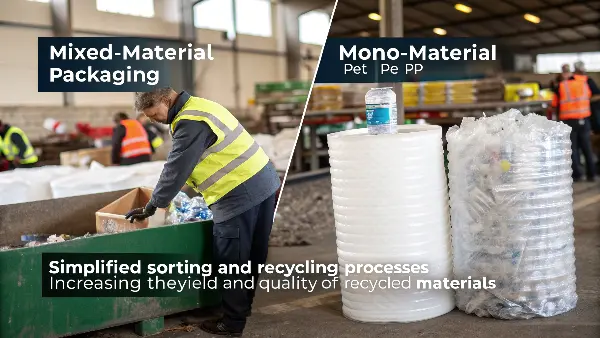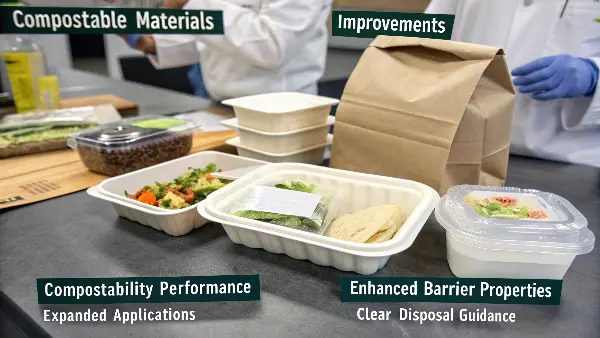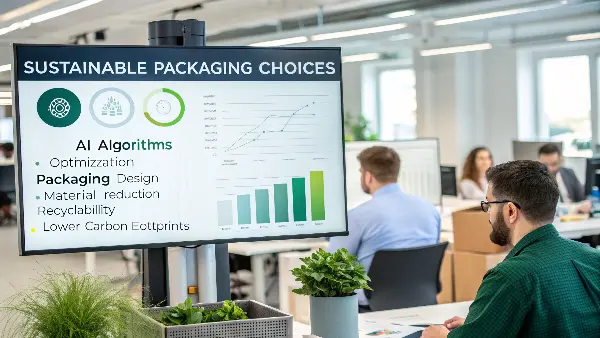Staying ahead in sustainable packaging is tough, with constant innovation. Are you prepared for the key trends that will define eco-conscious packaging choices next year?
Key trends include the expansion of refill/reuse systems, a stronger push for mono-material designs to improve recycling, advancements in compostable materials, and the growing influence of AI in optimizing packaging sustainability.
The world of packaging is shifting fast, driven by regulations, consumer demand, and the urgent need for better environmental outcomes. For professionals like Jacky, keeping up isn’t just about compliance; it’s about leading the change. At Ecosourcecn, we track these developments closely to support our partners. Let’s explore the trends likely to impact your sustainable packaging strategy in 2025.
Will Refillable and Reusable Models Finally Go Mainstream?
Single-use packaging dominates, but its waste legacy is undeniable. Could 2025 be the year where refill and reuse systems break through, offering a truly circular alternative?
Refillable and reusable models are gaining traction due to consumer demand and corporate goals. Success depends on convenient infrastructure, standardized containers, effective cleaning logistics, and clear consumer incentives to participate.
The idea of refilling containers isn’t new, but scaling it effectively has been challenging. We are seeing more pilots and investments, suggesting a potential tipping point.
Key Factors Driving Reuse/Refill
- Consumer Acceptance: Growing environmental awareness makes consumers more open to reuse, especially if it’s convenient and cost-effective. Brands are experimenting with in-store refill stations, returnable packaging programs (like Loop), and concentrated refills.
- Corporate Sustainability Goals: Many large companies have set ambitious targets to reduce virgin plastic use. Reuse models offer a direct way to achieve significant reductions compared to just switching materials.
- Technological Enablers: Digital platforms, smart containers with tracking (RFID/QR codes), and optimized reverse logistics are making complex reuse systems more manageable. Think about tracking return rates and cleaning cycles efficiently.
Challenges and Considerations
Despite the promise, hurdles remain: Challenge Consideration Infrastructure Requires significant investment in collection points, washing facilities, logistics. Standardization Lack of standard container sizes/formats hinders interoperability and scale. Consumer Behaviour Requires consumers to change habits (remembering containers, returning them). Hygiene & Safety Robust cleaning and sanitation processes are critical, especially for food. Cost Initial setup and ongoing logistics can be more expensive than single-use. I remember working with a client exploring reusable coffee cups for events. The logistics of collection, washing, and redistribution were far more complex than initially anticipated, highlighting the need for careful planning. For businesses like Jacky’s, evaluating where reuse fits—perhaps in B2B shipments or specific product lines—is becoming increasingly important. Success hinges on making it easy for everyone involved.
Why is Mono-Material Design Crucial for Better Recycling?
Mixed-material packaging looks appealing but often ends up in landfills. Is simplifying packaging structures the key to unlocking higher recycling rates and a more circular economy?
Mono-material packaging (using a single type of plastic like PET, PE, or PP) simplifies sorting and recycling processes, increasing the yield and quality of recycled materials, unlike mixed materials which are difficult to separate.

The push for recyclability is intensifying, and mono-material design is at the forefront. It directly addresses a major bottleneck in current recycling systems.
The Mono-Material Advantage
- Simplified Sorting: Recycling facilities (MRFs) rely on automated sorting technologies (like optical sorters). These systems easily identify and separate common mono-materials like PET bottles or HDPE jugs. Complex multi-layer structures confuse these systems.
- Higher Quality Recyclate: When materials are properly sorted, the resulting recycled pellets (like rPET or rHDPE) are purer and retain more of their original properties. This makes them more valuable and suitable for use in new products, including food-grade applications.
- Increased Recycling Rates: By making packaging easier to sort and process, mono-material designs contribute directly to higher overall recycling rates, moving us closer to a circular economy.
Transitioning to Mono-Materials
Making the switch isn’t always straightforward:
- Performance Challenges: Multi-layer packaging often exists for a reason – providing specific barrier properties (oxygen, moisture), strength, or sealability that can be hard to achieve with a single material. Finding mono-material solutions that meet these performance needs, especially for food preservation, requires innovation. We’re seeing advancements in PE and PP films designed for recyclability.
- Aesthetics and Feel: Brands might need to adapt their expectations regarding the look and feel of packaging if moving away from complex laminates.
- Cost Implications: Sometimes, the innovative mono-material alternative might initially be more expensive than the established multi-layer structure, although costs often decrease as scale increases.
I often talk with clients like Jacky about the specifications for their packaging. The request might be for "recyclable," but we need to dig deeper. Is it technically recyclable, or practically recyclable in the regions where the product is sold? Focusing on mono-materials widely accepted by local recycling infrastructure (like PET, HDPE, PP) is a much more effective strategy for real-world circularity. It requires collaboration between material scientists, packaging converters, and brands.What’s New in Advanced Compostable Materials?
Compostable packaging offers an end-of-life solution, especially for food-contaminated items. Are new breakthroughs making these materials more versatile, functional, and truly beneficial for the environment?
Innovations focus on improving compostability performance (faster breakdown, home compostable options), enhancing barrier properties for better food preservation, expanding applications beyond food service, and ensuring clear labeling and disposal guidance.

Compostable materials like PLA (polylactic acid) and Bagasse (sugarcane fiber) have become common, particularly in food service. But the next wave of innovation aims to address limitations and broaden their use.
Areas of Advancement
- Enhanced Performance: Research is yielding compostable materials with better heat resistance (like CPLA), improved flexibility for films, and enhanced barriers against oxygen and moisture, making them suitable for a wider range of products historically reliant on conventional plastics. Think shelf-stable food packaging.
- Home Compostability: While many current compostables require industrial facilities (high heat, specific microbes), materials certified for home composting (breaking down in backyard bins) are emerging. This increases disposal options for consumers but requires rigorous testing and clear certification (e.g., TUV Austria OK compost HOME).
- New Feedstocks: Exploring non-food feedstocks like algae, seaweed, or agricultural waste (beyond sugarcane) aims to reduce potential competition with food crops for land use.
- Clarity and Communication: There’s a growing recognition that clear labeling (using certified logos) and consumer education are vital. It’s crucial users know how and where to compost these items, distinguishing them from conventional plastics to avoid contaminating recycling streams.
Considerations for Implementation
- Infrastructure Access: The biggest challenge remains the availability of industrial composting facilities accessible to the end consumer. If these facilities aren’t available, the "compostable" benefit is lost. This is a key point I always stress with clients – know your target market’s infrastructure.
- Certification is Key: Ensuring materials meet recognized standards (like ASTM D6400, EN 13432) is non-negotiable. This guarantees they will break down as claimed under the right conditions. At Ecosourcecn, we prioritize sourcing certified materials.
- Avoiding Contamination: Compostable packaging accidentally entering the recycling stream is a major problem. Clear visual differentiation and consumer awareness campaigns are necessary.
For Jacky, evaluating advanced compostables means looking beyond the material itself to the entire system: performance needs, certifications, target market disposal infrastructure, and clear consumer communication. It’s about finding the right fit where composting offers a genuine environmental advantage.How Might AI Shape Sustainable Packaging Choices?
Artificial Intelligence is impacting many industries. Can AI help us design smarter, more sustainable packaging, optimize supply chains, and reduce waste more effectively?
AI can analyze vast datasets to optimize packaging design for material reduction, recyclability, and lower carbon footprints. It can also improve supply chain logistics, predict material life cycles, and enhance waste sorting.

Artificial intelligence offers powerful tools to tackle the complexity of sustainable packaging design and logistics. Its ability to process information and identify patterns can lead to significant improvements.
Potential AI Applications
- Optimized Design: AI algorithms can rapidly iterate through design options, considering factors like material usage, structural integrity, shipping efficiency (reducing empty space), and end-of-life scenarios (recyclability, compostability). This can lead to lighter packaging that still protects the product effectively. Imagine AI suggesting minor structural changes that save 5% material across millions of units.
- Material Selection: AI can analyze material properties, environmental impact data (LCAs – Life Cycle Assessments), cost, and regulatory compliance information to help designers choose the most sustainable option for a specific application. It could compare virgin plastic vs. recycled content vs. bio-based alternatives based on multiple criteria.
- Supply Chain Efficiency: AI can optimize logistics, reducing transportation emissions by planning better routes and consolidating shipments. It can also help predict demand more accurately, reducing overproduction and waste.
- Waste Sorting Enhancement: AI-powered robotics and optical sorting systems in MRFs can identify and sort materials with greater speed and accuracy, improving the quality of recycled feedstocks. AI could potentially learn to identify even complex or novel packaging types over time.
- Predictive Analytics: AI could model the environmental impact of different packaging choices over their full lifecycle, helping businesses make more informed decisions upfront.
Implementation Considerations
- Data Quality: AI relies on accurate and comprehensive data. Gathering reliable information on material properties, environmental impacts, and supply chain factors is crucial.
- Integration: Integrating AI tools into existing design workflows and supply chain management systems requires investment and expertise.
- Complexity: While AI can simplify choices, understanding the algorithms and their limitations is important to avoid unintended consequences.
I see AI as a potential game-changer for packaging specialists like Jacky. Instead of relying solely on experience or limited datasets, AI could provide data-driven recommendations to balance cost, performance, and sustainability targets much faster. While still emerging, it’s a trend we at Ecosourcecn are watching closely, as it could significantly accelerate the transition to smarter, greener packaging solutions.Conclusion
Staying informed about eco-packaging trends like reuse models, mono-materials, advanced compostables, and AI is vital. Adapting your strategy proactively will ensure your business leads in sustainability and meets evolving market demands.


